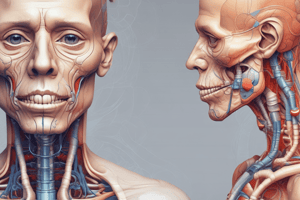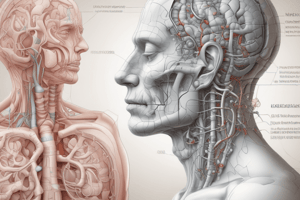Podcast
Questions and Answers
What is a critical initial management step in addressing dyspnoea in small animals?
What is a critical initial management step in addressing dyspnoea in small animals?
Oxygen supplementation is a critical initial management step.
Name one diagnostic technique important for evaluating respiratory conditions in dogs and cats.
Name one diagnostic technique important for evaluating respiratory conditions in dogs and cats.
Point of care ultrasound (POCUS) is an important diagnostic technique.
Explain how hypoxaemia and hypercapnia contribute to the perception of dyspnoea.
Explain how hypoxaemia and hypercapnia contribute to the perception of dyspnoea.
Hypoxaemia results in decreased oxygen levels while hypercapnia increases carbon dioxide, both contributing to a sensation of laboured breathing.
What conditions should be considered in the differential diagnosis when a pet presents with dyspnoea?
What conditions should be considered in the differential diagnosis when a pet presents with dyspnoea?
Why is it important to consider signalment when assessing respiratory disease in animals?
Why is it important to consider signalment when assessing respiratory disease in animals?
What are the key management techniques recommended for treating dyspnoea in small animals?
What are the key management techniques recommended for treating dyspnoea in small animals?
How does a thorough respiratory examination differentiate between upper respiratory tract disease and pleural space disease?
How does a thorough respiratory examination differentiate between upper respiratory tract disease and pleural space disease?
What mechanisms may contribute to dyspnoea in small animals exhibiting respiratory distress?
What mechanisms may contribute to dyspnoea in small animals exhibiting respiratory distress?
What are common differential diagnoses for dyspnoea in dogs and cats?
What are common differential diagnoses for dyspnoea in dogs and cats?
How can signalment assist in diagnosing respiratory diseases in small animals?
How can signalment assist in diagnosing respiratory diseases in small animals?
What is the importance of observing a patient from a distance during a respiratory examination?
What is the importance of observing a patient from a distance during a respiratory examination?
How can inspiratory effort indicate the presence of upper airway disease?
How can inspiratory effort indicate the presence of upper airway disease?
What historical information is crucial for assessing respiratory distress in patients?
What historical information is crucial for assessing respiratory distress in patients?
What does the presence of expiratory wheezes suggest in lower respiratory tract diseases?
What does the presence of expiratory wheezes suggest in lower respiratory tract diseases?
What role does signalment play in diagnosing respiratory diseases?
What role does signalment play in diagnosing respiratory diseases?
What symptoms might indicate pulmonary parenchymal disease?
What symptoms might indicate pulmonary parenchymal disease?
How can a history of coughing or recent illness aid in diagnosing respiratory conditions?
How can a history of coughing or recent illness aid in diagnosing respiratory conditions?
What is a common misconception when evaluating respiratory conditions, according to the phrase 'common things are common'?
What is a common misconception when evaluating respiratory conditions, according to the phrase 'common things are common'?
Flashcards
Respiratory Distress Localization
Respiratory Distress Localization
Identifying the location of respiratory problems (upper or lower airway, pleural space, or pulmonary parenchyma) by observing the patient's breathing patterns and auscultation.
Upper Respiratory Tract Issues
Upper Respiratory Tract Issues
Respiratory problems affecting the structures above the trachea (larynx, pharynx).
Lower Respiratory Tract Issues
Lower Respiratory Tract Issues
Respiratory problems affecting the structures below the trachea (bronchi, bronchioles, and alveoli).
Pleural Space Disease
Pleural Space Disease
Signup and view all the flashcards
Pulmonary Parenchymal Disease
Pulmonary Parenchymal Disease
Signup and view all the flashcards
History Taking (Respiratory)
History Taking (Respiratory)
Signup and view all the flashcards
Signalment Importance
Signalment Importance
Signup and view all the flashcards
Brachycephalic Obstructive Airway Syndrome (BOAS)
Brachycephalic Obstructive Airway Syndrome (BOAS)
Signup and view all the flashcards
Pleural Effusion
Pleural Effusion
Signup and view all the flashcards
Pyothorax
Pyothorax
Signup and view all the flashcards
Thoracocentesis
Thoracocentesis
Signup and view all the flashcards
Signalment
Signalment
Signup and view all the flashcards
Dyspnea
Dyspnea
Signup and view all the flashcards
Dyspnea in animals
Dyspnea in animals
Signup and view all the flashcards
Rational approach to dyspnea
Rational approach to dyspnea
Signup and view all the flashcards
Lookalikes for dyspnea
Lookalikes for dyspnea
Signup and view all the flashcards
Point of care ultrasound (POCUS)
Point of care ultrasound (POCUS)
Signup and view all the flashcards
Hypoxia and hypercapnia
Hypoxia and hypercapnia
Signup and view all the flashcards
Study Notes
Approach to Dyspnea in Dogs and Cats
- Presentation covered a rational approach to investigating respiratory distress (dyspnea) in small animals.
- Learning objectives included developing a rational investigation approach, recognizing different respiratory tract diseases, prioritizing management techniques, and appreciating point-of-care ultrasound (POCUS).
Preparation for a Rational Approach
- Essential preparation includes having oxygen readily available.
- Prepare intravenous catheter trays, quiet clippers, and thoracocentesis kits.
- Ensure ultrasound and crash kit are on hand.
- Note that rushing, stressing, & aggressive interventions should be avoided.
Oxygen Supplementation
- Oxygen supplementation is a key part of the initial response to pets showing respiratory distress.
- Gradual increases in oxygenation are important, ranging from 25-30% up to 80-100%.
- This slide demonstrates different animal cases requiring varying levels of oxygen supplementation.
Dyspnea - Difficult or Labored Breathing
- Sensory experiences such as pain, nausea, thirst, or hunger can influence dyspnea perception.
- Hypoxia (low blood oxygen) and hypercapnia (high blood carbon dioxide) exacerbate dyspnea.
- Concurrent pain can increase the perceived severity of dyspnea.
Look-alikes and History
Look-alike conditions needing investigation include:
-
Cardiovascular instability
-
Acid-base imbalances
-
Intracranial issues
-
Medication reactions (e.g., opioids)
-
Behavioral/environmental responses (fear, pain, anxiety)
-
Methemoglobinemia
-
Thorough history taking is vital; consider indoor/outdoor status to rule out trauma, historical coughing/wheezing, current medications, recent illness changes, and recent surgical/anesthesia events.
Observing the Patient
-
Remove the patient from the waiting area at triage.
-
Observe from a distance, aiming to localize the source of the respiratory distress focusing on:
- Upper respiratory tract
- Lower respiratory tract
- Pulmonary parenchymal
- Pleural space
- Thoracic wall/diaphragm
-
Breath sounds should be assessed to evaluate their intensity and effort required for breathing.
Localization of Respiratory Effort
- Inspiratory effort associated with extra-thoracic (upper) airway disease
- Expiratory effort associated with intrathoracic (lower) airway disease
- Asynchronous/inverse breathing patterns with reduced lung sounds point towards pleural space disease.
- Dull heart/lung sounds may accompany pleural space disease.
- Increased/moist auscultation findings suggest parenchymal disease.
"Upper" Respiratory Tract Conditions
- Laryngeal paralysis
- Brachycephalic obstructive airway syndrome (BOAS)
- Polyps
- Viral infections
- Neoplasias (e.g., lymphoma, squamous cell carcinoma)
"Lower" Respiratory Tract (Obstructive?) Conditions
- Feline inflammatory lower airway disease
- Tracheal/bronchial collapse
- Bronchitis
- Cough
- Systemically well animals with expiratory wheezing
Pulmonary Parenchymal Disease
- Pneumonia (infectious)
- Pulmonary edema (cardiogenic or non-cardiogenic)
- Neoplasia
- Contusions
Pleural Space Disease
- Pneumothorax
- Pleural effusions (chylothorax, pyothorax, haemothorax)
- Exfoliative neoplasia
- Congestive heart failure
Thoracentesis
- Thoracocentesis procedure uses ribs 7-9, cranial to the rib to avoid the VAN (vasculature).
- U/S guidance is beneficial.
- Tips for thoracocentesis include U/S guidance, bevel rotation, and flushing back.
Point-of-Care Ultrasound (POCUS)
- POCUS is a targeted ultrasound examination used to answer key clinical questions.
- Thoracic POCUS is used to assess pleural/pericardial effusions, pulmonary parenchymal disease (B-lines), and pneumothorax (Glide Sign).
- POCUS can be used to assess global heart function, including determining the relation between the aorta and left atrium.
Aspiration
- Aspiration involves foreign material entering the lungs, often indicated by X-ray images revealing diffuse interstitial markings
Conclusions
- Thorough history, patient observation from a distance, & identifying a true resting respiratory rate are essential steps.
- Point-of-care ultrasound (POCUS) is crucial for diagnostic investigation.
- Call for advice when necessary.
Summary (One Health Relevance)
- Improved animal health and welfare through prompt and accurate dyspnea investigation.
- Reduced antimicrobial prescriptions through proper diagnostic approach.
- Preservation of ecosystem health through minimized antimicrobial use.
Studying That Suits You
Use AI to generate personalized quizzes and flashcards to suit your learning preferences.




